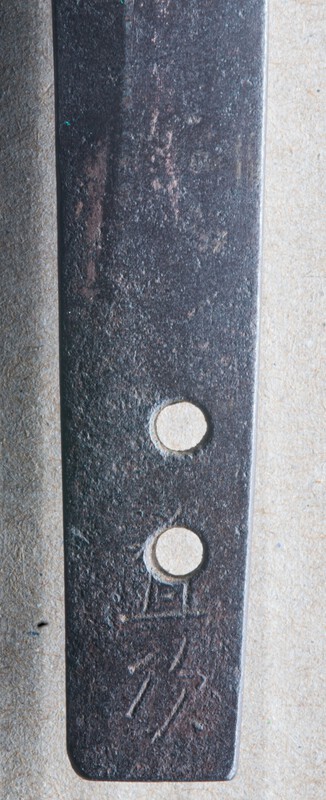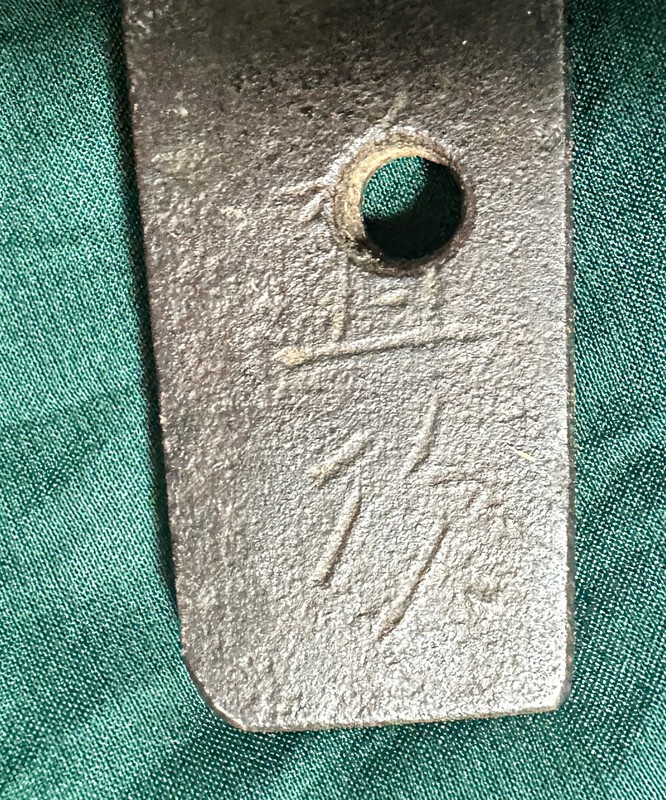-
Posts
1,996 -
Joined
-
Last visited
-
Days Won
15
Everything posted by Rivkin
-
Maybe if you show the full resolution section from the last two photographs where everything is in focus or otherwise have a well lit, in focus pictures of the hamon with a light source on the side (left or right) - in the first photographs it comes from the hamon's side in which case you can't see the hamon itself. Nevertheless - its something that wants to be Rai, but is not Rai. It feels certainly late Muromachi or later. Just hamon's width per se (its wide) is ot really consistent with earlier work, among other things. It could be late Muromachi Kaga, Bizen Kiyomitsu or a few other things but I don't think so for couple of reasons. It feels a bit more Edo period. Its probably not mainline Hizen because for Hizen this is an uncommon boshi. Nevertheless I think there is a strong Hizen influence - broad nioguchi, broad hamon, dense and uniform hada. I suspect its a nice sword overall. But all of it is a sort of wild guess based on such poor photos.
-
Well, these look like Soshu boshi. They are close enough to Yamato hakkikake but are much more complex. The images unfortunately are not fantastic and low resolution. Otherwise one could actually make some conclusions about the blades. The image quality is just not there. If one still has to guess, I would put the first blade above the second. I don't see large nie crystals in the second case, everything more or less the same in size. Generally very fine lines that are drawn as if by hand is a sign of later work. First one can be lower grade Norishige that has been poorly photographed. Second I would go into Gassan Sadakatsu territory.
-
Looks like ubu wakizashi, I would guess shinto. Unfortunately, with this period its hard to go to any more specific school attribution unless in full polish etc.
-
If its ubu then the nakago can be the decisive factor. Otherwise strong utsuri and tired spots close to shinogi which are consistent with Kongo. Also Kongo often have long-narrow kaeri compared to mainline Yamato, though I don't think its seen here...
-
I suspect some good and pre-1340 stuff. Yamato Taima or Tegai Kanenaga.
-
I see an interesting blade with shirake utsuri, ko itame, possibly masame in shinogi-ji (unclear), mostly nioi based hamon with a little bit of ko nie, with some unusual forging within it, but I would not call it mokume. Its a good photo, and I always enjoy guessing what it might or might not be by just one photo with activities. To me it looks like post-Kamakura work of some ambition, most likely late Muromachi-Tensho period....or maybe shinshinto?
-
It has certain late/Muromachi shinto vibes, and probably more of the latter - wide hamon which in places is very periodic, not much else seen so far (yes, its very much out of polish), boshi and sugata would be very helpful.
-
Below: Sadakatsu versus Masamune, I did not process either image to the fullest yet. As with most shinshinto and especially gendai which carries some study of Ikkansai Yoshihiro's approach - Sadakatsu's "Masamune" will have only small nie which does not sparkle too much and all forging lines are going to be pristine and well defined. Masamune will have at least two fukure, everything will be three notches brighter, nie size will be all over the board, transitions much more natural and irregular.
-
Deep fresh cuts, distinctive triangular strikes, likely no earlier than shinto. Which leaves two guys in the book (Sesko): TOMOMITSU (友光), Genroku (元禄, 1688-1704), Dewa – “Tomomitsu” (友光), Amaya family (天谷), he lived in Iizuka (飯塚) in Dewa´s Tsuga district (都賀郡) TOMOMITSU (友光), Shōwa (昭和, 1926-1989), Nagano – “Tomomitsu” (友光), family name Kamihara (上原), he worked as guntō smith, ryōkō no retsu (Akihide) Can be the second gentleman, but it works better with seeing the blade/activity.
-
Gunto with leather over traditional saya.
-
I picked up a blade which is pretty out of polish but in hands looks like Naminohira with ko-kissaki: utsuri, wavy coarse nagare which runs in a "pack" above the hamon, hamon in nie with Yamato style activities. The only thing which is not Naminohira-like to me is that the hamon is strongly in nie and is better than most Naminohira examples which tend to lack fine grained nie. Unfortunately the second kanji looks like tsugu, the first one I can't decipher... Any help will be greatly appreciated.
-
Thank you, as a proud dumpster diver I traded/bought without papers 95% of it. There are some old continental tsubas that were not on the table. The habaki is a part of koshirae which comes with two opinions: 1. By "all-American old school shinsa of tsuba and tosogu": in suite mainline Goto, too unusual to be more specific, custom order. 2. By an "honorary Russian shinsa of crafts and blades": a combinations of pieces, all by different Goto makers. Only one piece he identified as early mainline Goto, the rest in his opinion are three (!) different generations of lesser skill. Here are the detailed examples, unfortunately the o-kozuka did not come out perfectly in focus. O Kozuka Kurigata Kojiri Kojiri2 Habaki1 Habaki2
-
Unfortunately the tsuba has nothing to do with the blade and its a difficult case since the blade has been cut down significantly. If possible please take a good picture of the boshi and a photo of the activities, in both cases placing light way on a side rather than a bit from above, though the picture you took is not bad. There might be some potential here, though the chip is unfortunate.
-
Do you mind if I use these images in a possible future publication on signatures? I truly think its an amazing example.
-
There is a visible lens/view distortion (by looking at the nakago), but generally it is either the end of Muromachi-Tensho, or Kambun shinto. The writing where you place first kanji 2 inches up and then mash the remaining two on top of each other, the strokes of uneven depth indicate the person writing this most likely was not a professional. Same goes for placement - if you do bold, wide, deep lines - sign in the center, not at the edge. Tenten on vertical lines in a condensed kanji... Its painful to look at, but a great example of a signature that violates every single principle of calligraphy and how signature style elements should work together. This was not done by a smith. So we have a run of the mill late Muromachi to Kambujn waki with a bad signature.
-
Listening to the same people telling the same war stories, sometimes things evolve rather drastically after half a year. Less mud and s...t, more burning tanks and blazing machine guns. Location shifts from no-one-remembers-where to a popular spot. The enemy multiplies and closes in for hand to hand combat. I guess Mr. Sword somehow got involved in the process or maybe a son found it in his father's things and gave it to a friend with a story attached. I think the box is cool though.
-
These are shinto wakis with questionable signatures. 600$ is well, ok. Though there is not much to learn or see here. 1800$ on the other hand is a solid budget. At a show this buys a decent mumei Muromachi Bizen katana with papers, condition issues and plenty to see and appreciate.
-
Personally nothing strikes me here as good/outstanding, mei cut is a bit unusual, shinto pieces, though its just a first impression. Unfortunately, the closest sword show is quite a few months away... I would say look at aoi art and a few other beginner friends sites and see if there is something you like. Fishing among out-of-polish blades is a fun sport but not for beginners.
-
Tsuba are a good way to invite people. Otherwise my collection is quite small. collected a few tsuba, me likes Person visits - he studies good
-
This looks like the end of Edo period work and frankly its one notch below the Goto mainline. Does it have papers? How does the signature look like? Yes, the name is the late one, but I would question the attribution first, i.e. better photographs are needed. Saya and tsuka are probably post-WW2.
-

Thoughts on these types of listings
Rivkin replied to klee's topic in General Nihonto Related Discussion
Near dead Naminohira, no reason to polish (especially with a thin boshi) and despite koshi-zori possibly from 1500s rather than 1400s. -
Unfortunately I don't know this case exactly (i.e. handwritten+photograph, I've seen only handwritten+possibly rubbing), but from the past 40 years I've seen papers by upper class polishers whose names are not recognized in the west, as well as (less often) a few dealers or collectors. Frankly, unless its upper grade name was involved, most I've seen were honest and possible to accept opinions. From 1890-1940 there are many sword shop papers. They tend to be ignorant.
-
#1 shinto. Hizen Masahiro made those, many other people did. #2 very crisp and well defined o-maru boshi? Generally rare on later blades, Muromachi+. There is some taper involved. This is an old blade that was greatly cut down. Because of the unusual boshi and probably tight (invisible) jigane with suguha, guess Enju or Awataguchi. #3 Late Nanbokucho naginata, cut down. Attempting to guess without seeing the jigane or frankly anything except barely something outlining the hamon - Bizen or Yamato Shizu. #4 Circa 1640 shinto. In out-of-polish state I would pursue #2 and possibly #3. Does anything here has "great sugata"? Sorry - Not in my book. Some are good blades still. #2 probably used to have a good shape, but now it is 20% of the appeal it had as ubu.
-
I find many ubu kodachi to have exceptional sugata. Miniaturized mid Kamakura tachi where the slightest deviation would stand out and therefore distortion free shape is a perfection. Unfortunately a typical moved hamachi and squared nakago is more than enough to remove the harmony and produce a blade which is ugly shaped... even though there are still kantei features even sugata wise which suggest its kodachi and not a waki. For ubu piece it is often just simple. For example, in kodachi the curvature continues at the nakago's mune side. In a waki there is usually none, even if there is some above the nakago. Otherwise I think a considerable portion of the confusion here comes from NBTHK stating "its Kamakura shape" versus "its a great sugata". Though obviously I never seen the actual papers I don't feel the second option is the actual case. I don't think any of Kamakura period blades retains a great portion of its "shape aesthetic" in o-suriage. It can still be attractive, but not nearly as much as ubu. It can still be kantei-ed by kissaki alone, yet it remains butchered, in the harshest cases to the point it becomes a straight and flimsy stick affixed to a bizarre curved foundation.
-
I think as a first blade to purchase, its a good choice. But there are couple of things I don't like about it. For example, "masame" does not change much as it crosses from hamon's area towards the ji and back. While it states in the description as sunagashi and kinsuji, you get this effect when hamon is not tempered into hard nie. So this blade is bright, but with Dotanuki better blades always show a lot of nie activity which is very much subdued here. Its both atypical and not the best.










